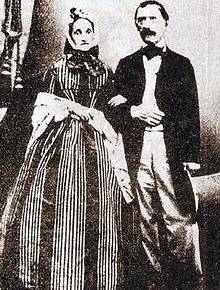Jacob Christoph Rad
Jacob Christoph Rad (born March 25, 1799 in Rheinfelden , † October 13, 1871 in Vienna ; also Jakub Kryštof Rad ) was the manager of a sugar factory and went down in history as the inventor of the sugar lump .
Life
Jacob Christoph Rad was born as the son of a military officer from the front of Austria . His father had family roots in Brugg, Switzerland . He was later transferred to Tarnów in Galicia and from there to Vienna in 1808. The son was apprenticed to a chemist in the capital . Jacob Christoph Rad spent his journeyman time abroad. In 1835 he returned to Vienna. When he married Juliane Schill in 1839, he was unemployed. His career progressed possibly through good connections from his wife.
Jacob Christoph Rad was entrusted in 1840 with the management of the sugar factory of the Datschitz rule in the Moravian Datschitz (today's Dačice ), which belonged to Baron Karl Anton von Dalberg . During this time he began trying to extract sugar cubes. In fact, he managed to machine raw sugar into cubes. In these experiments, Rad was largely funded by the local property manager Franz von Grebner (1791-1851).
On January 23, 1843, Rad was granted a five-year privilege for the invention, and the following year a patent for the sugar cube press was granted. The so-called tea sugar or Viennese cube sugar was produced in Datschitz .
In 1846, Rad moved to the Chamber of Commerce in Vienna as secretary for three years . As a creative spirit, he was busy with another invention. An optical telegraph system did not catch on, however. The trial line built on the Istrian coast in 1849 did not meet the expectations of the innovation.
The inventor therefore withdrew back into the sugar industry and gave, among other things, the address book and yearbook of the Austrian-Hungarian beet sugar factories and refineries, as well as the recorded companies of the alcohol distilleries. out. He died in Vienna in 1871 as the father of 15 children.
Sugar in the 19th century
Before the invention, sugar was produced in the form of sugar . These were large pieces of granulated sugar in the shape of a cone, which were rock-hard after the sugar mixture had cooled down. Such a sugar loaf came on the market in sizes up to 1.50 m high and was expensive. If sugar was needed in the household for a coffee break, for example, smaller pieces had to be removed from this cone. One used a tool that was offered in the form of a sugar hammer, sugar hoe, sugar breaker or sugar tongs. When the hard mass was maltreated, injuries occurred to the hands of the service personnel. Rad's wife Juliane is said to have injured herself while making sugar sticks.
Rad thought about how he could manage smaller pieces. He created a model from sheet metal strips that resembled a current bowl for ice cubes . He let the sugar loaf grate. The tiny pieces were now slightly moistened and filled into the model. When everything was dry, you now had acceptable sugar cubes. Based on these basic considerations, he perfected his sugar cube press. As an alternative to the usual sugar sugar, it was sold by the trade, who also sold the sugar syrup that is produced during the boiling process of sugar.
Honor
A monument was erected in Dačice in 1983, commemorating the sugar lump and its inventor.
literature
in alphabetical order by authors / editors
- Jana Bisová: The Chamberlain from Worms in Bohemia and Moravia . In: Kurt Andermann (Hrsg.): Ritteradel in the Old Kingdom. Die Kämmerer von Worms named by Dalberg = work of the Hessian Historical Commission NF Bd. 31. Hessische Historische Kommission, Darmstadt 2009. ISBN 978-3-88443-054-5 , pp. 289-316.
- M. Habacher: Wheel Jakob Christof. In: Austrian Biographical Lexicon 1815–1950 (ÖBL). Volume 8, Verlag der Österreichischen Akademie der Wissenschaften, Vienna 1983, ISBN 3-7001-0187-2 , p. 366 f. (Direct links on p. 366 , p. 367 ).
- Wener Kohl: A front Austrian invents the lump sugar in The Austrian Sugar Industry and its History (s) 1750-2013 , pp. 97 ff. Böhlau-Verlag, ISBN 978-3-205-79498-1
Web links
Individual evidence
- ↑ What is sugar? Food sugar ( Memento from January 15, 2005 in the Internet Archive )
- ↑ Bisová: The Chamberlain , p. 300.
- ↑ Bisová: The Chamberlain , p. 300.
| personal data | |
|---|---|
| SURNAME | Rad, Jacob Christoph |
| ALTERNATIVE NAMES | Rad, Jakub Kryštof |
| BRIEF DESCRIPTION | Austrian inventor of the sugar cubes |
| DATE OF BIRTH | March 25, 1799 |
| PLACE OF BIRTH | Rheinfelden AG |
| DATE OF DEATH | October 13, 1871 |
| Place of death | Vienna |

